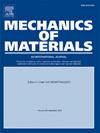On-the-fly meanfield transition-state theory for diffusive molecular dynamics
IF 3.4
3区 材料科学
Q2 MATERIALS SCIENCE, MULTIDISCIPLINARY
引用次数: 0
Abstract
We apply transition state theory to derive atomic-level master equations for mass transport from empirical interatomic potentials within the Diffusive Molecular Dynamics (DMD) framework. We show that meanfield approximation provides an exceedingly efficient and accurate means of computing free-energy barriers in arbitrary local atomic configurations, thus enabling long-term DMD ‘on-the-fly’ and on the sole basis of an underlying interatomic potential, without additional modeling assumptions. We apply and validate the resulting meanfield DMD paradigm in simulations of processes of hydrogenation and dehydrogenation of Mg using Angular-Dependent interatomic Potentials (ADP). We show that meanfield DMD correctly predicts hydrogen diffusivities in hcp Mg and vacancy diffusivities in rutile . We demonstrate the ability of meanfield DMD to predict evolution through calculations concerned with dilute concentrations of hydrogen in hcp Mg, and with dilute concentrations of hydrogen vacancies in rutile , including off-stoichiometry hydrogen concentrations and temperature effects. Remarkably, the time steps required by DMD are up to six orders of magnitude larger than those required by Molecular Dynamics (MD), which demonstrates the overwhelming superiority of the DMD paradigm in simulations of phenomena occurring on the diffusive time scale.
扩散分子动力学的动态平均场过渡态理论
我们应用跃迁态理论从扩散分子动力学(DMD)框架内的经验原子间势推导出质量输运的原子水平主方程。我们表明,平均场近似提供了一种非常有效和准确的方法来计算任意局部原子构型中的自由能势,从而实现长期的DMD“动态”,并且仅基于潜在的原子间势,而无需额外的建模假设。我们利用角相关原子间电位(ADP)模拟了Mg的加氢和脱氢过程,并验证了结果的平均场DMD范式。我们证明了平均场DMD正确地预测了hcp Mg中的氢扩散系数和金红石MgH2中的空位扩散系数。我们证明了平均场DMD能够通过计算hcp Mg中的稀氢浓度和金红石MgH2中稀氢空位浓度来预测演化,包括非化学计量氢浓度和温度效应。值得注意的是,DMD所需的时间步长比分子动力学(MD)所需的时间步长高达6个数量级,这表明DMD范式在模拟扩散时间尺度上发生的现象方面具有压倒性的优势。
本文章由计算机程序翻译,如有差异,请以英文原文为准。
求助全文
约1分钟内获得全文
求助全文
来源期刊

Mechanics of Materials
工程技术-材料科学:综合
CiteScore
7.60
自引率
5.10%
发文量
243
审稿时长
46 days
期刊介绍:
Mechanics of Materials is a forum for original scientific research on the flow, fracture, and general constitutive behavior of geophysical, geotechnical and technological materials, with balanced coverage of advanced technological and natural materials, with balanced coverage of theoretical, experimental, and field investigations. Of special concern are macroscopic predictions based on microscopic models, identification of microscopic structures from limited overall macroscopic data, experimental and field results that lead to fundamental understanding of the behavior of materials, and coordinated experimental and analytical investigations that culminate in theories with predictive quality.
 求助内容:
求助内容: 应助结果提醒方式:
应助结果提醒方式:


